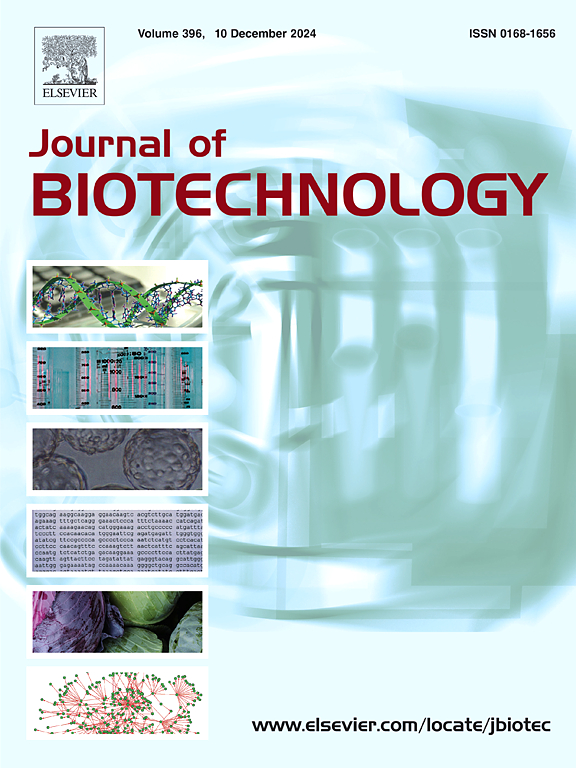Identification and engineering of a sucrose synthase from Stevia rebaudiana for glycosylation applications
IF 3.9
2区 生物学
Q2 BIOTECHNOLOGY & APPLIED MICROBIOLOGY
引用次数: 0
Abstract
Sucrose synthase (SuSy) is a unique glycosyltransferase that can be utilized in the production of nucleoside monosaccharides, such as diphosphate (UDP)-glucose, which serve as essential sugar donors for the glycosylation reactions catalyzed by UDP-dependent glycosyltransferases (UGTs). The selection of an appropriate SuSy coupled with a UGT is crucial for achieving the efficient synthesis of glycoside products. In this study, three candidate SuSy genes were identified from the transcriptome sequencing of Stevia rebaudiana, among which SrSUS1 was found to be expressed and active in Escherichia coli. The optimal temperature and pH for SrSUS1 were determined to be 55°C and pH 7.0, respectively. A variant SrSUS1T49A/L90P/V104E was generated based on a consensus sequence strategy, exhibiting a 3.6-fold increase in activity and the enhanced affinity for sucrose (Km = 52.32 mM), as well as the improved thermal stability and catalytic efficiency. By coupling SrSUS1T49A/L90P/V104E with glycosyltransferase UGTAn85Q23E/N65D or UGT76G4, respectively, the production of 163.32 mM (43.63 g/L) of 2-phenylethyl-β-D-pyranoside and 72.29 mM (93.35 g/L) of rebaudioside M was achieved within 24 h in one-pot, two-enzyme fed-batch reactions. This study provides new insights into plant-derived SuSys and presents a promising biocatalyst for industrial glycosylation applications.
甜菊糖基化蔗糖合成酶的鉴定与工程研究。
蔗糖合成酶(SuSy)是一种独特的糖基转移酶,可用于生产核苷单糖,如二磷酸(UDP)-葡萄糖,它是由UDP依赖的糖基转移酶(UGTs)催化的糖基化反应的必需糖供体。选择合适的SuSy和UGT对于实现最佳的糖苷产物合成至关重要。本研究通过甜叶菊转录组测序鉴定出3个候选蔗糖合酶基因,其中SrSUS1在大肠杆菌中表达并具有活性。SrSUS1活性的最佳温度为55℃,pH为7.0。基于一致序列策略生成了一个变体SrSUS1T49A/L90P/V104E,其酶活性提高了3.6倍,对蔗糖的亲和力增强(Km = 52.32mM),并且提高了热稳定性和催化效率。将SrSUS1T49A/L90P/V104E分别与糖基转移酶UGTAn85Q23E/N65D和UGT76G4结合,在一锅双酶补批反应中,在24h内可合成163.32mM (43.63g/L)的2-苯乙基-β- d-吡喃苷和72.29mM (93.35g/L)的雷博迪苷M。该研究为植物源性SuSys提供了新的见解,并为工业糖基化应用提供了一种有前途的生物催化剂。
本文章由计算机程序翻译,如有差异,请以英文原文为准。
求助全文
约1分钟内获得全文
求助全文
来源期刊

Journal of biotechnology
工程技术-生物工程与应用微生物
CiteScore
8.90
自引率
2.40%
发文量
190
审稿时长
45 days
期刊介绍:
The Journal of Biotechnology has an open access mirror journal, the Journal of Biotechnology: X, sharing the same aims and scope, editorial team, submission system and rigorous peer review.
The Journal provides a medium for the rapid publication of both full-length articles and short communications on novel and innovative aspects of biotechnology. The Journal will accept papers ranging from genetic or molecular biological positions to those covering biochemical, chemical or bioprocess engineering aspects as well as computer application of new software concepts, provided that in each case the material is directly relevant to biotechnological systems. Papers presenting information of a multidisciplinary nature that would not be suitable for publication in a journal devoted to a single discipline, are particularly welcome.
 求助内容:
求助内容: 应助结果提醒方式:
应助结果提醒方式:


